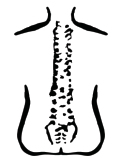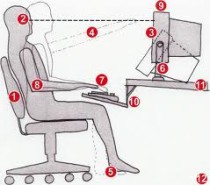COMPUTER WORKSTATION ERGONOMICS
- Use a good chair with a dynamic back. Set the tension so you can sit against the back of the chair without tilting. Your buttock should be pressed firmly against the back of the chair to maintain good posture. You should be sitting upright. If possible, use a lumbar roll to support your lower back.
- Position the top of the monitor 3 - 4" above eye level. Use telephone books if you need to raise the monitor higher than it will adjust on its own.
- Use a non-glare screen or purchase an anti-glare filter to fit over the monitor. This will prevent unnecessary eye strain.
- Position yourself approximately arms-length from the monitor.
- Place your feet flat on the floor or on a stable footrest. Your knees should be slightly lower than your hips in the chair.
- For entering data from paper, use a document holder positioned at the same height as the monitor.
- Keep the back of your wrists flat and straight in relation to your forearms.
- Your arms and elbows should remain relaxed and close to your body. You should not have to reach for the keyboard. Ideally, you will have a 90 degree bend at the elbows with your hands resting comfortably on the keyboard.
- Center the keyboard and monitor directly in front of you.
- If necessary, use a negative-tilt keyboard tray. The mouse should be positioned immediately next to the keyboard. DO NOT place the mouse or keyboard on an elevated surface.
- Use a stable work surface and keyboard tray (no bouncing while you type).
- Take frequent short breaks (microbreaks) about every 15 - 20 minutes. This helps prevent poor posture and fatigue.


